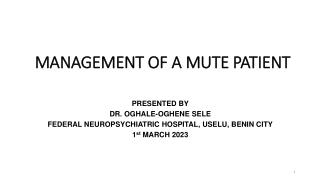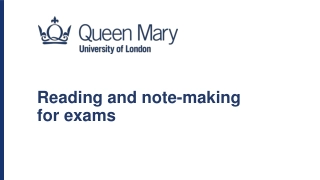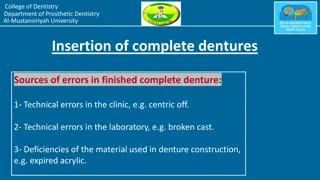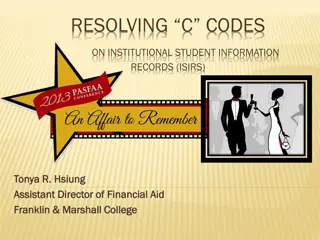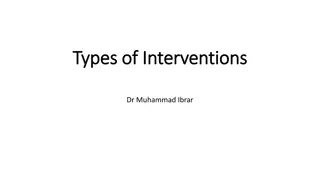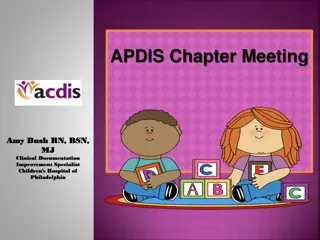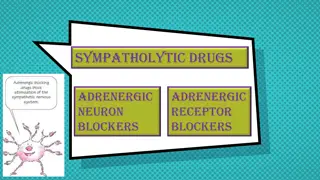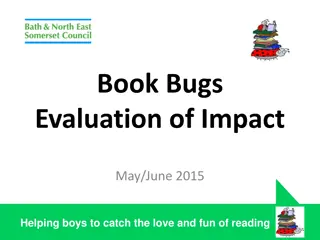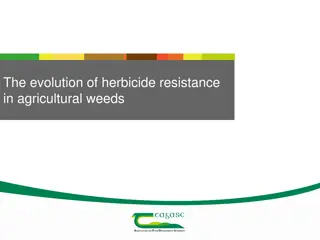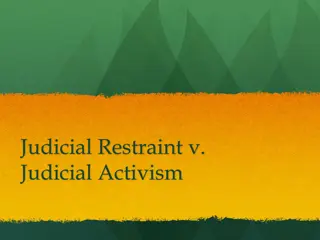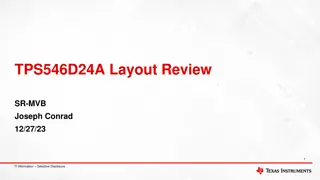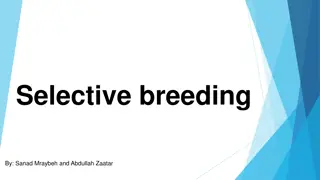Understanding Selective Mutism: Diagnosis and Intervention Overview
Selective Mutism (SM) is an anxiety disorder affecting children, characterized by a fear of speaking in certain environments. This overview delves into what SM entails, its symptoms, severity levels, diagnosis methods, and best practice intervention strategies. It also explores real-life case studies and the importance of early detection for effective treatment. Expert insights from psychologists and clinicians shed light on unlocking the mystery of SM and aiding children in overcoming social anxiety.
Download Presentation

Please find below an Image/Link to download the presentation.
The content on the website is provided AS IS for your information and personal use only. It may not be sold, licensed, or shared on other websites without obtaining consent from the author. Download presentation by click this link. If you encounter any issues during the download, it is possible that the publisher has removed the file from their server.
E N D
Presentation Transcript
selective mutism intervention Laura Sander Regional Psychologist s meeting September 29, 2023
WHAT IS SELECTIVE MUTISM (SM)? BEST PRACTICE INTERVENTION agenda REAL LIFE INTERVENTION: 2 DIFFERENT CASE STUDIES DISCUSSSION
SM: first encounter Unlocking the Mystery of Selective Mutism and Social Anxiety Aimee Kotrba, Ph.D. (clinical psychologist) March 9, 2015 DVD 6 hr recorded seminar $250 2023 selective mutism intervention 3
what is selective mutism? Anxiety disorder o 90% of kids with SM also have social phobia o SM: fear of speaking o Social phobia: fear of attention Self-protective, usually not oppositional Kids aren t CHOOSING (selecting) to not speak; select because it occurs in select environments Difference between shy and SM: o Shy is a personality style that appears across all environments o SM is an anxiety-based behaviour that only occurs in select environments 2023 selective mutism intervention 5
what is selective mutism? Severity oSevere: doesn t speak outside of the home setting o Moderate: speaks to some school staff members 1-on-1 o Mild: answer direct question (quiet, short); doesn t initiate NO causal relationship between SM and abuse, neglect, or trauma o 10% have experienced; same prevalence as all children Tend to: o Be intelligent: ~105 FSIQ o Be bilingual: 33% o Have a language disorder or reading disorder 2023 selective mutism intervention 6
what is selective mutism? Diagnosis oEasier to treat the earlier it s diagnosed o DX: 6 months into first year of school experience o Who: doctors (pediatricians, psychiatrists), psychologists, psychiatric nurses, SLP Assessment o Selective Mutism Questionnaire (SMQ) o School speech questionnaire (SSQ) (not normed) o SCARED or MASC o Non-verbal IQ test 2023 selective mutism intervention 7
best practice intervention
treatment I don t want to do something, because I don t want to make it worse oResearch shows that it s always better to do something than nothing o SM gets harder to treat as the child gets older (e.g. age 15+) Belief that kids will do well if they can; if they can t, then what is it in their environment that is preventing that? Operational definition of success: increase of speech in social situations selective mutism intervention 2023 9
treatment Evidence based treatment: o Behavioral therapy: #1 evidence-based treatment o Medication and parent training (tie) o DIR floor time o Play therapy Efficacy o Medical: helps 50% of kids o Behavioural: helps 65% of kids o Both: helps 80% of kids 20% who aren t helped are typically older kids; learned behavioral repertoire Age 8 and younger easier to treat, age 9 and older harder to treat selective mutism intervention 2023 10
steps for implementing treatment 1) Build rapport 2) Psychoeducation 3) Teach to assess own anxiety 4) Desensitization (exposure therapy) selective mutism intervention 2023 11
building rapport Hey Jimmy, we get to play together and get to know each other a little bit today, we have toy, game, game, toy; you can pick whatever you want. PRIDE: Praise (labelled) Reflection: saying back what they say to you Imitation: doing the same thing they re doing Description, behavioral: provide commentary of interaction with child Excitement: show you like to be there! selective mutism intervention 2023 12
psychoeducation Younger kids (3-7 years old): o Minimal o Doing Brave Work Older kids (9+ years old): o See image Class/friends: o May need to provide oBooks: Charli s choices selective mutism intervention 2023 13
fading selective mutism intervention 2023 14
teach to assess own anxiety Don t call IT anxiety ; how HARD was that? o How hard would it be to use your brave talk in the library? o Scale 1-10 o Helps monitor progress selective mutism intervention 2023 15
selective mutism intervention 2023 16
selective mutism intervention 2023 17
desensitization (exposure therapy) Increasing ability to communicate through facing fears at a reasonable pace Shaping: reinforcing successive approximations to speech. Use when there is no pre-existing speech outside of the home Stimulus fading: slowly bringing in new people and moving preexisting speech to new places Escape extinction: for small percentage of kids who don t want to do the brave work (shaping & fading); use their desire to escape to your benefit Contingency management: reward system; great to use, not enough on its own Other: o Cognitive work (ages 13+): Shyness and Social Anxiety Workbook o Social skills instruction: if needed selective mutism intervention 2023 18
shaping Use when there is no speech occurring at school; need to get them talking with one person in one place Communication ladder: start where they re already at (don t go below) selective mutism intervention 2023 19
shaping: communication ladder 1) Following directions 2) Non-verbals (pointing/nodding/shaking head) 3) Body sounds 4) Oral-motor exercises 5) Blowing air 6) Voiceless sounds 7) Voiced sounds 8) Sound combos 9) 1-word answers 10) Multiple word answers and longer utterances 11) Spontaneous initiation of conversation selective mutism intervention 2023 20
shaping: communication ladder You can shape within a step (e.g. balloon) You can move to a new step when 2 things are happening: oChild is compliant oThey don t look really outwardly anxious It may be that you re blowing air for 30 seconds or for 4 full sessions Can move on to a new step within the same session selective mutism intervention 2023 21
generalizing the ladder What to do when you ve successfully reached giving one word answers: o Forced choice questions: increase communication demands in situations where talking has been established o Fading: begin generalizing speech to other situations A note on volume: whispering begets whispering o App: decibel (measures volume) o App: talking tom selective mutism intervention 2023 22
Forced Choice Question First No Response Second No Response Verbal Response Wait 5 sec, prompt for verbal Wait 5 sec, repeat question Labeled Praise No response or nonverbal Verbal response Wait 5 sec, reduce expectations Labeled praise selective mutism intervention 2023 23
from shaping to fading Once speech has been established, need to move it to new people or places; breaking the speech boundaries Fading is easier than shaping o Fading in a new environment is easier than a new person usually o However, a new person is usually more functional (e.g. teacher) Use the fear hierarchy of people/places established at beginning and reassess every so often o Only change one factor at a time (person or place) o Still practice in original environment occasionally selective mutism intervention 2023 24
selective mutism intervention 2023 25
escape extinction If child isn t into doing the brave work , try: oSet small achievable goals: Here s the work you have to do; when you re done then you can have a prize and leave o Set timer; have them do the goal (e.g. pointing) for the whole time. Pause if they stop. Prompt if needed oIf they don t care about the timer (want to miss class): have session before the end of school (e.g. wants to go onto the bus, not miss going home) If child still won t engage in therapy, then work on parents reducing accommodation; may help kids get better by default selective mutism intervention 2023 26
reducing parental accommodation Protective parenting practices: o LACK of family accommodation: rescuing child from anxiety, e.g. speaking for kids, not expecting kids to speak o High expectations: assume kids will be ok and successful, we re going to do this; it s going to be ok o Being involved at school Maintaining parenting practices o Accommodations: #1 predictor of maintaining SM. When child gets anxious, parent gets anxious o Social isolation: e.g. parents with anxiety disorder o Denial of an issue: I was just like them, and I was ok selective mutism intervention 2023 27
reducing parental accommodation Give education about NOT rescuing: o If you rescue at the height of the fear, you steal the sense of mastery and pride of accomplishment and success o Allow them to ride it out First time will be really tough!! After doing it over and over again, it will be ok 6 - 10 times before mastery and before anxiety goes away When a kid answers, don t cause a big reaction wow you talked that s amazing! oLabelled praise is good: thanks for that answer selective mutism intervention 2023 28
contingency management Make non-verbal communication not reinforcing Make VERBAL communication reinforcing o Talking gets the good stuff o Reward system Plan B: if the child doesn t order at a restaurant; parent CAN order for them, but talking gets the good stuff. So parent would order food that s not as appetizing (e.g. veggies). selective mutism intervention 2023 29
implementing desensitization Who does it? o Case manager: person in the school who is responsible for doing the intervention; can be anyone who can be trained, has time, interest, and desire to do what s best for the kid o Mental health professional outside of school (once a week therapy session and also parent training) o Parent selective mutism intervention 2023 30
treatment course Have to practice FREQUENTLY. Can t force a kid to speak, but can certainly prompt with slow steps to speak o At school: 5-10 mins daily or 15-20 mins 3x a week o Outside school: professional therapy session once per week o Parents practicing several times a week (e.g. in community) Average length of treatment: o 3 months: amazingly quick o 2 years: usually older kids Most common cause of regression: someone forced child to talk in a situation when they weren t ready to talk selective mutism intervention 2023 31
donts for treatment Don t mind read; talking gets the good stuff! Don t use open ended questions Don t show disappointment Don t demand verbal manners and proper names (very difficult for kids with SM). Do last. Don t say don t worry no one can hear you selective mutism intervention 2023 32
adaptations Selectivemutism.org has adaptations plan for kids online Seated next to someone who they talk to or are likely to talk to o Close to teacher, away from door Allow for early arrival/warm up time in the morning (even 5 mins to make a connection with the teacher) Evaluation methods: o Videotaping at home, show to teacher > then show to class o Audio record, have them hold up recorder in class Begin fading in April with the new teacher oBring friend to next class (but don t use as a crutch) Summer school visits if possible selective mutism intervention 2023 33
real life intervention
case study #1 (2018) Female in grade 6 (age 12) Presenting concerns: disturbing drawings, lack of speech, learning difficulties Early history: maternal family history of anxiety disorders, maternal smoking during pregnancy, long labour (72 hrs), lazy eye surgery at age 2, toilet training not completed until age 4, older sister also didn t speak in kindergarten but grew out of it by grade 1, separated parents 2023 35 selective mutism intervention
case study #1 Report cards oVery good achievement: science, gym, music oGood to basic: social studies oBasic: ELA and math oAcceptable attendance AEP developed in grade 2 oSpeech/language, social-emotional, math, ELA Received small group support from resource teacher oMath: 3x per school cycle for whole year oReading: 3x per school cycle for 6 months o Go Zen anxiety program: 3x per cycle for 7 months (1-on-1) 2023 36 selective mutism intervention
case study #1 Speech at school o Spoke with teacher or resource teacher 1-on-1 in either classroom or RT office with door closed Assessment o Intervention concurrently with assessment o Used fading procedure with resource teacher; 3 sessions 2023 37 selective mutism intervention
case study #1 WNV: o NV FSIQ: Low Average (80) WIAT-III: o Basic reading: Very Low (74) o Reading comp: Average (93) o Mathematics: Very Low (78) o Sentence composition: Low Average (85) o Spelling: Very Low (79) 2023 38 selective mutism intervention
case study #1 MASC-2: o Parents: Extremely High social anxiety o Student: inconsistent response style; Very High performance fears SMQ: o At home: speech difficulties are less severe than most children with SM o In public: more severe (mother) and less severe (father) o At school: more severe DX: Social Anxiety Disorder, confirmed SM 2023 39 selective mutism intervention
case study #1 Treatment team: o Me o Resource teacher o EA X 2 oClassroom teacher Because she was already talking in some situations at school, we used the fading procedure o I started doing sessions and eventually trained and faded in 2 different EAs to take over o ~6 months o Twice a week, 30 mins each 2023 40 selective mutism intervention
case study #1 Speech BEFORE intervention People: Classroom teacher Resource teacher Speech AFTER intervention People: o Classroom teacher o Resource teacher o Me Me o Librarian Librarian o 2 EAs 2 EAs o 2 2 friends friends Places: o Classroom (whispering behind hand) (whispering behind hand) o RT office (door open) (door open) o RT outer room (door open) RT outer room (door open) o 2 other RT offices (doors open) 2 other RT offices (doors open) o Library Library o Private room in library (door open) Private room in library (door open) o Hallway outside classroom Hallway outside classroom o Conference room (door open) Conference room (door open) Places: Classroom (empty, door closed) RT office (door closed) 20XX presentation title 41
case study #1 Operational definition of success: increase of speech in social situations Using the fading procedure, the student improved: o 6 steps on the people fear ladder o 9 steps on the places fear ladder 2023 42 selective mutism intervention
case study #2 (2022-2023) Female in grade 1 (age 7) Presenting concerns: lack of speech, won t eat at school, toileting (won t change soiled pull up or clothing), continues to wear mask, long bangs in face, difficulty separating from mother to get on bus in morning Background info: mother had SM as child, 1 older sibling with SM currently (high school, wears mask as well, open to CMH), strong academically, good attendance 2023 43 selective mutism intervention
case study #2 IEP developed o Toileting Teacher/RT taking for regular bathroom breaks Shaping behaviour in bathroom also Private bathroom o Social-emotional Inviting friend for lunch in a separate room o Intervention plan: fading procedure Classroom teacher, resource teacher, me, EA, VP, school social work o Classroom adaptations 2023 44 selective mutism intervention
case study #2 Speech at school o Used to speak with EA and classroom teacher occasionally in kindergarten in the classroom or library o At the start of grade 1 she no longer spoke to anybody o Decided to start with fading Met with EA (K) for 25 mins in my office (in library) 3x per week Plan to fade in Laura once she freely spoke with EA After 19 sessions, still no speech with EA Switched to shaping on session 20 o Started with body sounds since she already did non-verbals 2023 45 selective mutism intervention
case study #2 Shaping progress extremely slow Teacher went on leave, had to hire 2 teachers (am and pm) to replace Started having meltdowns at school, hard to determine triggers o Sometimes having an object misplaced (e.g. headband) Toileting accidents got worse, became oppositional with bathroom breaks and when Mom came to pick her up Refusing to change mask when soiled (e.g. coughing phlegm) even in private Attendance started dropping 1 or 2 calls to CFS from community members 2023 46 selective mutism intervention
case study #2 School social worker became involved We started working with Mom more o Provided psychoeducation o Asked her to schedule Dr. appointment to rule out physical causes of toileting issues o Mom shared that toileting issues are the same at home; screams when puts on underwear. Even though she talks at home, won t talk when asked about toileting. o Completed referral for Strongest Families for toileting & anxiety Started teaching calming strategies and developed secret signal with teacher 2023 47 selective mutism intervention
case study #2 Dr. appointment: o Referred for X-ray of stomach o Referred to Sterling Lyon Pediatrics for ASD rule in/out Added even smaller steps on the communication ladder to find success o Between step 5 (blowing air) and step 6 (voiceless sounds) we added step 5.5 (blowing air with sounds; e.g. musical instruments played by mouth) 2023 48 selective mutism intervention
case study #2 March 2023 EA working with student went on leave and I took over fading April 2023 Mom stopped following up with appointments and referrals o Would agree with us at meetings o Strongest Families referral expired May 2023 some spontaneous small successes o Making lots of nonsense sounds in hallways and in classroom o Began talking to lunch friend in room with door open; mask off to eat oWhispered in teacher s ear in classroom 2023 49 selective mutism intervention
case study #2 Operational definition of success: increase of speech in social situations Fading/shaping sessions summary: o November 1, 2022 May 12, 2023 o 39 sessions o ~30 mins each Shaping (communication ladder): o Began at step 2 of 12 (non-verbals) o Ended at step 9 of 12 (sound combinations; cat sounds) o Student improved 7 steps o Never got to try fading procedure due to lack of one-word utterances 2023 50 selective mutism intervention


